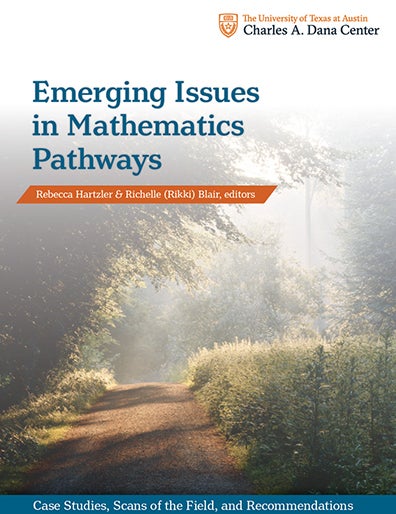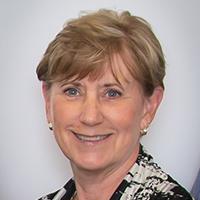
A Perfect Storm: Ten Years of Mathematics Pathways
 This is the first in a series of blog posts exploring topics in the recently released Dana Center Mathematics Pathways (DCMP) monograph Emerging Issues in Mathematics Pathways: Case Studies, Scans of the Field, and Recommendations. You can download the monograph, in full or as individual chapters, from the DCMP website.
This is the first in a series of blog posts exploring topics in the recently released Dana Center Mathematics Pathways (DCMP) monograph Emerging Issues in Mathematics Pathways: Case Studies, Scans of the Field, and Recommendations. You can download the monograph, in full or as individual chapters, from the DCMP website.
As we release the edited volume Emerging Issues in Mathematics Pathways: Case Studies, Scans of the Field, and Recommendations, I’m reminded of the summer of 2009. That year, a “perfect storm” occurred. A group of leaders met to discuss the future of mathematics in postsecondary education. At issue was the low success rate of students in mathematics and the degree to which mathematics stood as a barrier to student achievement.
These professionals—true power players from the mathematics community and interested entities such as AMATYC, MAA, ASA, the Dana Center, the Carnegie Foundation, and the Gates Foundation—gathered to discuss how mathematics was failing our nation’s students. Putting aside any personal biases, they were willing and ready to look for viable solutions. Concerns about course content and instructional strategies, particularly in developmental sequences, were floated, teased apart, and explored.
They worked together to redesign course content, create supports for students, and change the way postsecondary mathematics would be taught. For the first time—in a long time—the mathematics community was open to discussing new paradigms together.
I had the privilege of being part of this perfect storm, a term Dana Center founder Uri Treisman and I used at the time to describe what we saw occurring around that table. Admittedly, the metaphor of a perfect storm can denote both positive and negative ideas, but that was the point. Not everyone agreed about what should be considered major issues or the best ways to move forward, and we knew the path ahead could be contentious. We assembled, ready to break down barriers, and build consensus.
The result: the mathematics pathways movement was launched.
Mathematics Pathways: From Idea to Implementation
At its core level, the mathematics pathways movement is a re-envisioning of developmental mathematics content, with a particular focus on the mathematics students needed for their chosen majors.
The traditional Calculus path, leading students through multiple courses of Algebra, could no longer be the goal for all students. The “joyful conspiracy”—another term coined by Professor Treisman to describe this collaborative action—gradually led to the design of new pathways in Quantitative Literacy, Statistics, and STEM.
Over the ensuing years, as mathematics pathways implementations began to proliferate, students across the United States enrolled in pathways courses aligned with their majors. Faculty restructured lessons, courses, and course sequences. New delivery models were implemented to include emporium settings, co-requisite courses, and others. Institutions examined their placement methods and course scheduling. They offered more equitable services, provided training for faculty and staff, and changed policies to better support student needs. State departments of education and legislators engaged in dialogues with faculty and administrators to address issues and craft policies to support the implementation of pathways.
With dozens of pathways implementations in institutions and states around the country, the community learned from experience how to identify and better address challenges both organizational and cultural.
However, many of the same issues we explored a decade ago are still in play. Additionally, new challenges have emerged over that time. Ours is a dynamic, changing landscape that is complex and always needing thoughtful analysis and actionable planning.
In many ways, Emerging Issues in Mathematics Pathways: Case Studies, Scans of the Field, and Recommendations is the story of mathematics pathways as seen 10 years into implementation. I had the pleasure of helping to guide and edit this volume, whose chapters were written by professionals who have been involved with pathways in numerous capacities and across all aspects of the field.
These authors bring decades of on-the-ground, pathways-specific experience to bear in crafting recommendations for future pathways innovations and in posing new questions that will undoubtedly inform the field in coming years.
We hope you find these chapters useful as we continue to work towards improving student success in mathematics education.
About the Author
Rikki Blair
As professor of mathematics and department chair at Lakeland Community College in Kirtland, Ohio, Rikki worked diligently to promote active learning for her students and to bring technology into the curriculum. Among other activities, she is the author of two textbooks, has served as president of the American Mathematical Association of Two-Year Colleges (AMATYC), and co-edited the DCMP volume Emerging Issues in Mathematics Pathways (2019).
Get in Touch
We collaborate with state districts and teachers to develop innovative curricula, resources, and professional development.

